Doolittle Raider Lt. Col. Dick Cole
by ANN Contributor Tom Griffith
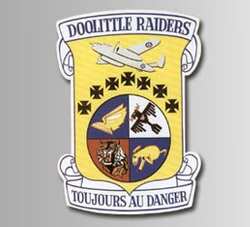 Editor's Note:
It's been quite awhile since we heard from contributor Tom
Griffith, ANN's freelance warbird enthusiast and aficionado. We
were happy to learn that after a self-imposed hiatus that saw the
birth of two more grandkids for him and his wife, Louise -- Judson
James Smith, born in March 2006, and followed two weeks later by
Olivia Sarah Foley -- Tom has returned to warbird photography with
a vengeance.
Editor's Note:
It's been quite awhile since we heard from contributor Tom
Griffith, ANN's freelance warbird enthusiast and aficionado. We
were happy to learn that after a self-imposed hiatus that saw the
birth of two more grandkids for him and his wife, Louise -- Judson
James Smith, born in March 2006, and followed two weeks later by
Olivia Sarah Foley -- Tom has returned to warbird photography with
a vengeance.
Armed with his new Olympus SLR, Tom recently made the
trip down to the gulf coast, to the Lone Star Flight Museum in
Galveston, TX... and returned "with maybe 600 photos." A few of the
best are presented here... along with one heck of a story.
Enjoy.
Anyone who knows how to "Google" anything knows that you can
hook up to the Internet, type any number of words into your
favorite search engine and find out facts about the famous
Doolittle Raid over Tokyo in April, 1942. You can see photos of the
aircraft, the aircraft carrier USS Hornet, Jimmy Doolittle, his
crews, their mission and all that. You can read accounts of "what
it was like to be there."
Your Google search will result in a lot of historical and
technical data: that Dick Cole was an Army Air Corps 2nd Lt. when
he volunteered with a number of other airmen for a top-secret air
raid; where they trained; who the other Doolittle Raider airmen
were; where and how their B-25s were specially modified for the
mission, and so forth. You can discover how hard it is to take off
from a relatively small aircraft carrier in a fully-loaded
land-based twin-engine bomber, fly at wave-top height for 650 miles
to bomb Tokyo, Kobe, Yokohama or other Japanese cities, what the
outcome of the mission was, how all of the planes were lost, how
many crewmen there were who didn't survive that first day after
crash landing or parachuting, etc.
You may even be surprised to find out that Jimmy Doolittle, who
later received the Medal of Honor for leading this raid, expected
to return to the United States to face a Court Martial because all
of the planes and some of the men were lost -- all for a mission
with only limited damage to Japan. You get the idea.

I had the singular opportunity to meet and talk with Lt. Col.
Dick Cole, USAF Ret., on April 28 and 29, just a couple of weeks
after the 65th anniversary of the famous mission over Tokyo. For a
91-year-old man, Col. Cole still stands up proud and has a
seemingly "aw shucks" attitude about his role in the historic
mission. To think that I not only would be able to attend the Lone
Star Flight Museum's airshow in Galveston, TX, shoot hundreds of
photos of my warbirds, catch a little sun with my wife, have an
airshow corn dog, and all that good stuff, but also, meet the guy
who flew right-seat in Jimmy Doolittle's B-25 on the Tokyo raid --
that was almost too much. I planned to ask him all sorts of nuts
and bolts questions about his B-25, how it felt in his seat just to
the right of the leader of the attack, his fears on that mission,
what it was like to go on a near-suicide mission, etc and then it
hit me that all of this is already "out there" in books and on the
Web.

Our conversations, maybe 15 or 20 minutes total over two days,
gave me an insight into this representative of the Greatest
Generation (by the way, HE, thinks that the US service personnel
fighting the current War on Terror are their own Greatest
Generation) and what life is now like for someone who is one of
only fourteen surviving members of the original 80 men who flew on
the mission.
We talked about what he did after WWII and how, after being
recalled into the Air Force when the Korean Conflict brought the US
into yet another foreign war, he decided to stay in the Air Force
and make a career out of it. I did, however, ask a few questions
about the types of aircraft in which he accumulated several
thousand hours. After all, as a life-long aviation nut and
sometimes-pilot myself, I had to ask a few of these questions that
were already answered elsewhere.
"Everything except fighters," was Col. Cole's reply. He retired
in 1967 and now is a resident of Comfort, TX, a little town not
that far from San Antonio. He lives a very simple life and doesn't
even have his own access to the Internet or his own e-mail address
(or, maybe he DOES and just wants to stay the private citizen that
he is) -- he says he's now a "country boy."
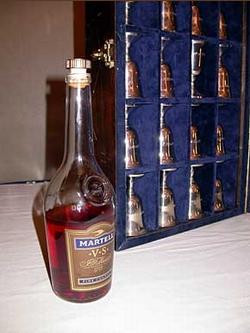 The second day that I
visited with him, I asked where he had been staying in Galveston.
He told me that he spent the night in the Moody Gardens Hotel,
which is right next to Scholes Field, the home of the Lone Star
Flight Museum and its airshow -- he indicated that it was a "pretty
nice hotel."
The second day that I
visited with him, I asked where he had been staying in Galveston.
He told me that he spent the night in the Moody Gardens Hotel,
which is right next to Scholes Field, the home of the Lone Star
Flight Museum and its airshow -- he indicated that it was a "pretty
nice hotel."
Everything about Col. Cole is this way -- he apparently has
NEVER seen why so many people have made heroes out of him and his
fellow Doolittle Raiders, even to the point of knowing that with
the death of one more of them earlier this year, there were now
only he and 13 others remaining.
There is a tradition that the Doolittle Raiders have had since
1979 -- they have a bottle of Cognac of 1896 vintage (the year of
Doolittle's birth) and 80 goblets, one for each of the Raiders.
When one dies, his goblet is turned over ceremoniously by either
one of the survivors or representative from the USAF.
When they are down to only two survivors, they will open the
bottle and drink a toast to their comrades. As an aside, I learned
from the Internet -- because Col. Cole is not the type of man to
mention it -- that Col. Cole, himself, made the wooden case in
which the goblets are stored at Wright-Patterson Air Force
base.
Father Time cannot be cheated -- with the youngest of the
survivors approaching 90 and the oldest approaching 100 years of
age, time will only tell who the final two are.
My bet is that Col. Dick Cole will be one of them because his
"retirement" includes taking care of himself, his home and his
garden. I read in a DefenseLink news article that Col. Cole himself
expects to be one the last two.
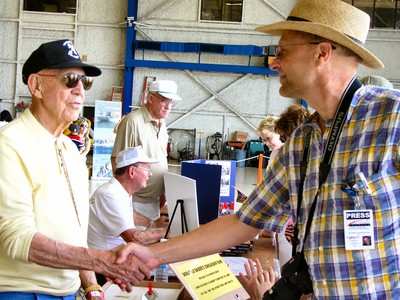
Back to the visits with Col. Cole... We talked about the B-25
that the LSFM has had for many years. It had been restored as a USN
PBJ in its blue and white paint scheme and has always been my
favorite Mitchell, and, it's the ONLY B-25 that I've ever flown in. Just days
before, the Museum had received the Mitchell back from the paint
shop where it had been re-done as a USAAF B-25 in the color and
insignias that the B-25s of 1942.
It now has a basically olive-drab dark green color scheme, has
Stars with the "meatball" in the center, "US ARMY" on the underside
of the wing, and some of the "newer" hardware removed (the side
"packet" .50 Cal Browning Machine Guns were gone, making it look
more like an early model B-25 - Doolittle's bombers were B-25-Bs
and the LSFM's bomber is a B-25-J with post-WWII modifications to
the air intake and exhaust systems, to name a couple of obvious
changes that are apparent to the warbird nut).
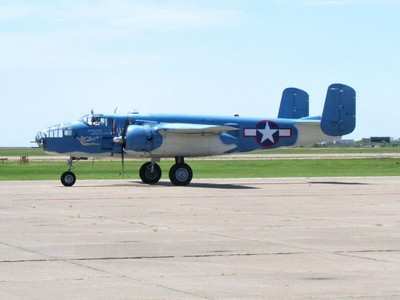
I am not knocking this rendition of a Tokyo Raider, but all that
is needed to make it REALLY look like the B-25-Bs that Doolittle's
men flew would be a rear top turret and a single .30 Cal BMG in the
nose. As it were, this is what I call the "newest B-25 Mitchell."
While we were sad to see our blue and white "Special Delivery"
(shown above) redone as the tribute to the Doolittle Raiders
(although still named "Special Delivery," but with no glamorous gal
nose art!), seeing this beauty (below) takes a way some of the pain
of our loss.
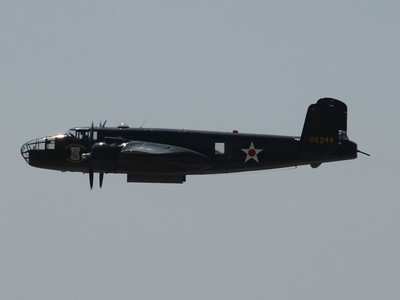
Col. Cole had posed beside her, and inside her, but told me that
he hadn't had a ride in her yet. He has flown in other B-25s since
the War, though. A B-52 Stratofortress had flown over Scholes
during the airshow and Col. Cole told me that he didn't get to see
it, because he was inside the Museum's big hangar when it flew
overhead. He said that he DID get to see the USAF B-2 Spirit
"Stealth Bomber" when it flew over during the airshow, and how it
looked like a "T-square with saw-teeth." I told him that my own
dad, a 20th Air Force radioman who'd died over 15 year ago, would
have liked to see how far things have come since WWII when they
made their individual sacrifices along with millions of other
servicemen (and more than a few women) to win WWII.
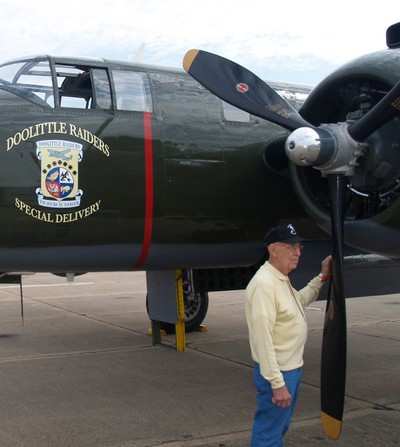
But as usual, I digress.
During one of our later conversations, I told Col. Cole that one
of my all-time favorite movies was "Thirty Seconds Over Tokyo" and
asked how accurate it was compared to the "real thing." His only
comments were that it was an OK movie, and that he really was
pleased that Spencer Tracy was chosen to play the part of Jimmy
Doolittle. I'd learned enough about Dick Cole, the man, to know
that he didn't want me to do anything stupid like ask who it was
who played HIM in the movie, or if his character, not being one of
the major characters in this movie adapted from Ted Lawson's book
of the same name, was even developed in the movie. He'd have just
told me that they ALL were just a bunch of Army fliers and they
were given a job for which they'd been trained and that they did it
to the best of their ability.
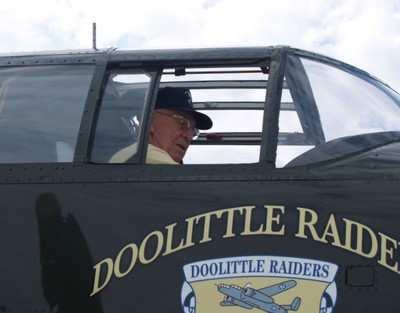
I asked him about his children -- he is the father of five. I
asked if any of them served in the military and he replied to the
affirmative: one son entered the USAF and among other aircraft,
flew the F-15 Eagle. He retired from the USAF, just like his dad.
Col. Cole told me about a grandson who had recently graduated from
the Air Force Academy and who was currently "in training" with the
USAF. I didn't ask Col. Cole about his wife, having read somewhere
that she had died a few years ago - I now wonder if I shouldn't
have asked about how their life had been, what with him being a
USAF pilot and raising the five children. I sound like I'm
repeating myself but meeting and visiting with a REAL,
flesh-and-blood, member of Doolittle's Raiders, Doolittle's own
co-pilot, none-the-less, still floored me.
Back to today's War on Terror. Col. Cole likened it to
a "modern Crusade," and shook his head. He said that 65 years ago
everyone knew "who the enemy was" and "what country they were from"
and that they were in uniforms. Today, you can't tell your friends
from your enemies. Leave it to 91 years of clear thinking to come
to this simple conclusion.
In closing, I must relate a story that is totally unrelated to
Col. Cole being Doolittle's co-pilot.
Just before I visited with Col. Cole one last time, I
was photographing people coming up, meeting him, shaking his hand,
getting his autograph, etc. The air in Galveston was in the 70's or
80's and while the big LSFM main hangar was cooler than it was in
the sun, it was still warm and humid. Someone had brought Col. Cole
a bottle of water and he had set it down on the table next to him,
lid off, to shake hands with a visitor. He accidentally knocked the
bottle off the table and spilled much of it onto the floor. Someone
brought a roll of paper towels that didn't do a very good job of
soaking up the water.
Without so much as a word, Col. Cole walked out from behind the
arranged tables, over to the doorway into the LSFM's machine
shop/tool room. A minute later, he emerged, carrying a mop. He
began to mop up the water that the paper towels had left behind and
then, with his mission accomplished, he returned the mop to the
shop and came back to the tables.
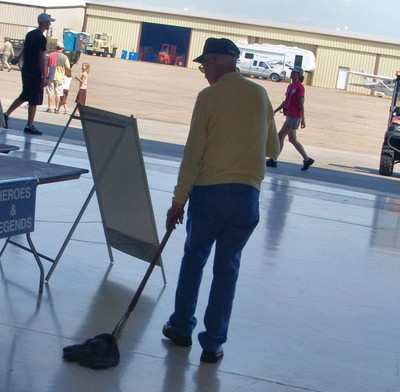
I immediately saw what can only be described as a metaphor for
this man and his generation: they saw a job that had to be done,
then they got the tools needed to do the job, they did it, and then
they returned to what they were doing when the problem presented
itself.
 Classic Aero-TV: The Switchblade Flying Car FLIES!
Classic Aero-TV: The Switchblade Flying Car FLIES! ANN FAQ: Q&A 101
ANN FAQ: Q&A 101 ANN's Daily Aero-Term (04.12.24): Discrete Code
ANN's Daily Aero-Term (04.12.24): Discrete Code ANN's Daily Aero-Term (04.13.24): Beyond Visual Line Of Sight (BVLOS)
ANN's Daily Aero-Term (04.13.24): Beyond Visual Line Of Sight (BVLOS) ANN's Daily Aero-Linx (04.13.24)
ANN's Daily Aero-Linx (04.13.24)












